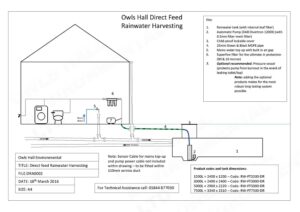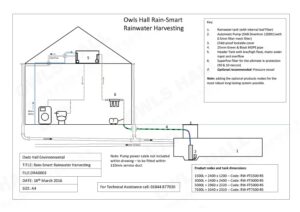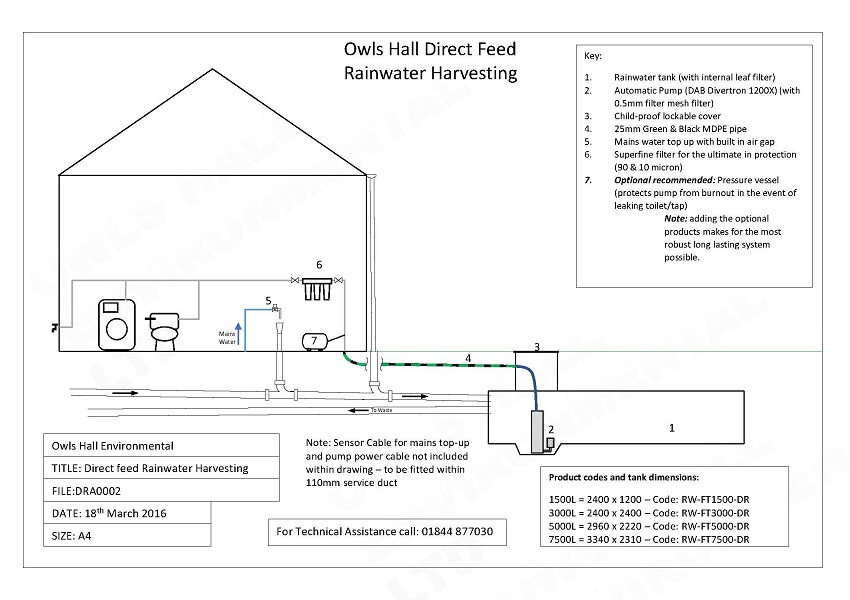Varying styles of rainwater harvesting
There are a few different styles of rainwater harvesting systems, we will look at the most popular and explain how they work and why you would use them.
- Garden watering systems. A garden rainwater harvesting system collects rainwater from the roof for the sole purpose of garden watering (and car washing). These systems come in two main forms, above ground and below ground. We will talk about the benefits of these two options later on. Water collected from the roof is stored in a tank and it is filtered prior, or on entry to the tank to remove leaves, keeping the water quality good. A pump either in, or outside the tank, will draw water out of the tank for you to use on the garden. Below ground systems will have a submersible pump, which will operate automatically on demand. They normally pump water to a tap or taps which you (or a builder) would install around the garden. If you haven’t got the ability or space to install taps around the garden there are self contained packages available.
- Domestic “house and garden” systems. A domestic system for the house and garden is a little more complex. Water quality has to be much better and there can be no risk of fine particles getting into the system. But they work on the same principle. Water from the roof is filtered upon entry to the tank, and pumped to the house for use in the home. Rainwater can safely be used for toilet flushing, clothes washing, garden use and car washing. Untreated rainwater cannot be used for drinking, bathing, showering, hand washing or dishwashing. A domestic system can either pump the water to a headertank in the loft, or directly to the toilets, washing machine, etc. A headertank system is called an “indirect system” and pumping directly to the toilets is called a “direct feed” system.
Versions of the Domestic – House and Garden system
As discussed, there are two different versions of the house and garden systems, the “direct feed” and “Indirect feed” systems.

In the direct feed system, you will notice that there is a mains top up. This adds a small amount of water to the rainwater tank when the water levels are low keeping the tank “topped up” with a little water. This has to be done to ensure you don’t run out of water. There can not be a switch over valve as this would present risk of cross contamination of your mains water supply.

The indirect system has a mains water supply to the headertank. In the event that the pump stops (due to a power cut or the tank has run out of water” the water in the headertank would drop and the mains would top it up, maintaining an uninterrupted water supply.
Indirect vs Direct Feed.
Deciding which is best for a particular build is not too easy, the most popular systems are direct feed systems. With a direct feed system, you are reliant on the pump and mains water back up, so ensure your pump is from a credible manufacturer and your mains back up kit uses heavy duty brass magnetic valves, ensuring long term trouble free operation. When weighing up the difference between the two styles, the below table may help.
|
Indirect Feed |
Direct feed |
| Requires loft space |
Yes |
No |
| Works when there is no power |
Yes |
No |
| Gives good pressure to washing machines |
No |
Yes |
| Requires mains top up to main storage tank |
No |
Yes |
| Requires mains water to loft |
Yes |
No |
| Offers ability to flush toilets multiple times without pump turning on |
Yes |
No |
Above or below ground?
As discussed previously, systems can be above or below ground. Below ground is normally better for water quality. This is because the water is cold and dark, preventing algae growth. For house systems it is recommended to use an underground tank if possible. Our shallow dig tanks are specifically designed to be easily installed below ground. Above ground tanks are normally installed when there is no ability to dig holes, or there is sufficient room to store the tank (behind a garage or workshop for example). Whilst water quality can sometimes be compromised a little with above ground tanks, for garden watering this normally isn’t an issue.
The importance of filtration
There are four stages to filtration in a domestic rainwater system:
- Leaf removal. The key to filtration is to remove leaves from the water before they degrade, if they degrade then they form a sludge which can make the water a little smelly. We install a leaf filter in our tanks to perform this task, it is self-cleaning but like all filters, you should check your filter a few times in the first couple of years to determine a pattern. Each site is individual with varying amounts of leaf fall, therefore discovering the pattern is important so you know when to check your filter. Cleaning the filter is a simple job of removing any leaves from the filter or sometimes just blasting it with a hose.
- Settlement of sediment. Sediment can build up in the tank over time. It is very slow to happen and can take decades. It is perfectly normal and should not cause concern. This being said you want the sediment to stay in on the floor of the tank and not be disturbed. Therefore we fit our filter tanks with a calming inlet to prevent disturbance.
- Pump filtration. Having a fine filter on the inlet of the pump is vital to ensuring any stones or fine grit do not get sucked up into the pump (for example, opening the lid and something falling in whilst the pump is running). This filter can’t be too fine otherwise the pump would struggle to suck the water through it. 0.5mm is a good rule of thumb.
- After pump filtration. If your system is well maintained and has the above three in place then there should be no need for additional filtration. But as a protection measure only, an additional filter should be added after the pump. The best place for this is in the house not directly on the pump (preventing the need to take out the pump just to look at the filter). Filters after the pump are there to protect against any fine particles blocking toilet valves. (for example some mud dropping into the tank while the pump is running). The higher quality filter here the better. Normally after pump filters do not need to be checked or changed very often (2-5 years on a normal system), 10 years+ on a system where leaves are kept out well. Some manufactures do not include these filters, claiming the water quality is so good from their system that it is not needed. However, water quality is as much to do with site conditions and cleaning leaf filters as it is about the system itself. So be cautious about installing anything without a filter after the pump. We recommend the Hydra-Rainmaster Trio for this job.
Take home message
A rainwater harvesting system is a great investment, especially if you are doing a new build or undertaking a big project in the garden. A little thought into the system and it can give a lifetime of water supply. Given that the south east is predicted to get more water shortages in the next few decades, it could prove to be a huge asset in years to come.


